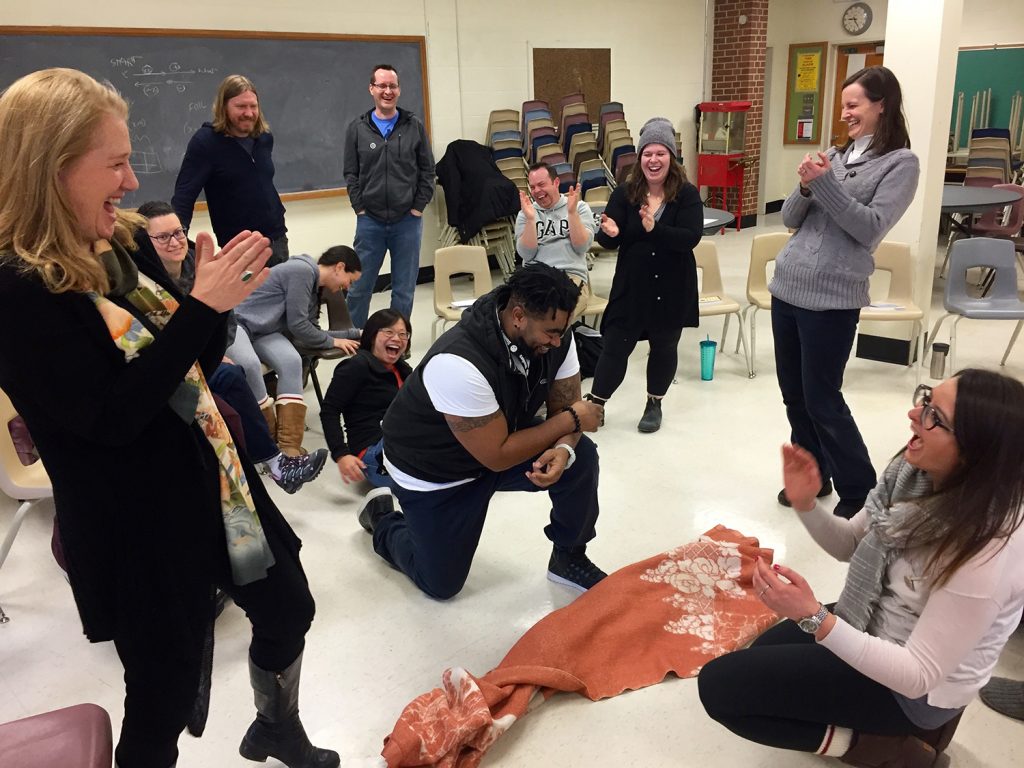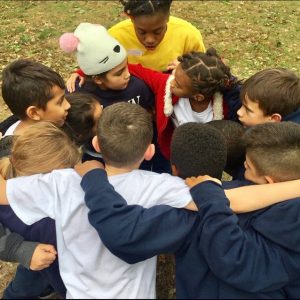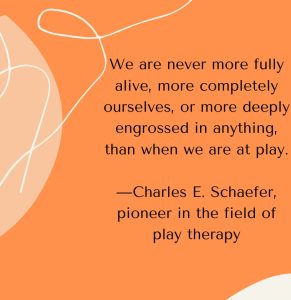Feb 08, 2024 Harnessing the Power of Play
Never underestimate the power of play in learning! Play is a serious subject. There is a great deal of research on play and what constitutes true play, types of play, and stages of play.

Teachers Engage in the Power of Play During a Professional Development Workshop
My working definition of playful learning involves engaging learners in educational activities, games, and creative group-building experiences that are:
- intrinsically motivating, inspiring ownership and choice on the part of learners with freedom to experiment within a safe and inclusive space
- engaging and active, including movement, social interaction, and use of multiple senses
- enjoyable and rewarding and including moments of challenge and frustration balanced with support, success, joy of achievement, and helping others
- focused on the process, discovery (and lessons learned along the way)
- flexible and changing
Playful learning situations enhance academic and social and emotional outcomes, create supportive learning communities, instill a desire to learn, and inspire a sense of discovery. Learners of all ages can develop and practice necessary life, work and academic skills through play. Respected advocates for 21st century learning promote playfulness, games, and collaborative group challenges in teaching.
Play and active playful communication and problem-solving activities are ways for educators to meet the diverse needs of learners. They are tools to teach and reinforce academic content in engaging ways.
Play contributes to the development of one of our most important brain functions—the ability to control and modify our behavior in order to reach a goal. Adults, adolescents, and children all learn and can potentially “change their brains” through play, as Sandra Aamodt and Sam Wang write in Welcome to Your Child’s Brain.
Research from educational neuroscience suggests that interactive social play improves executive function (the skills necessary for daily life, such as self-control, working memory, focus, flexible thinking, and handling emotions). Check out Adele Diamond’s research on how good executive function is a better predictor of success in school and later in professional life than a child’s IQ.
People learn self-regulation when they practice taking turns and focusing on the different tasks necessary to participate in a game. Playing safely, staying within boundaries, following rules, and other regulatory skills are necessary for play. Structured and unstructured interactive play is a powerful way to improve executive function in children and adults because many of the cognitive processes involved have plasticity, meaning that parts of the brain can be physically changed through ongoing practice of the desired skill or behavior.
Harnessing the Power of Play to Teach

Peer Leaders Co-Facilitating Play
Games require social rules, boundaries, and structure in order to work. Lev Vygotsky, a 20th century Russian psychologist and proponent of experiential learning methods, argued that, in play, a child learns to follow social rules because following these rules leads to pleasure. Because play is desirable, participants are motivated to practice rules of self-regulation in ways they might not in everyday life.
Because the brain processes involved in executive function have plasticity, they are best developed through hands-on practice. Play, especially play that involves problem-solving tasks, social interaction, planning, reasoning, and multiple senses, encourages mental growth and self-regulation skills, as shown by modern neuroscience researchers such as Aamodt, Wang, and Diamond.
Studies on brain structure and chemistry show that play activates norepinephrine (also known as noradrenaline), which arouses attention, increases sensory gain and the impact sensory information makes on the brain. Dr. Judy Willis shares in her publications that play improves brain plasticity and enhances learning by arousing attention.
Play and Dopamine
Dopamine is an important neurotransmitter involved with awareness, attention, and mood. When we experience something pleasurable, our dopamine levels increase. Dopamine is associated with the reward center of the brain and a heightened sense of pleasure. Playful learning experiences can trigger this “reward center” by increasing positive associations with learning.
When teachers engage participants in learning activities that correlate with increased dopamine release, they will likely get them to respond not only with pleasure, but with increased focus, memory, and motivation (Willis, 2012). Playful approaches that use multiple senses can create multiple pathways to learning, which educational neuroscientists like Judy Willis describe as a phenomenon in brain development: the more senses are engaged in practicing a lesson, the stronger and more plentiful the neuronal pathways become.
In short, the more ways in which something is learned and practiced, the easier it is to recall and access that information .
Many educators worry that play gets in the way of time spent on academics. I believe play doesn’t have to be separate from academic content. Rather, integrating play leads to more effective teaching and learning. Studies on play and learning, as Elena Bodrova and Deborah Leong describe in the American Journal of Play, show that children in classrooms where teachers use play as a teaching tool for sustained periods of time score higher in literacy skills.
Play also helps educators connect with their students and learn new ways to support them. Games and playful activities help differentiate instruction and provide opportunities for formative assessment..
 Play offers opportunities for inclusion, adaptation, and creativity. Playful activities can promote inclusivity by bringing ALL of the learning community together in the classroom. When I go into my local middle school to offer community building and active content review, we make sure all students in that grade are present, even if they are usually pulled out for special education support during that period. This inclusive grouping initiates positive changes in the students’ social interactions.
Play offers opportunities for inclusion, adaptation, and creativity. Playful activities can promote inclusivity by bringing ALL of the learning community together in the classroom. When I go into my local middle school to offer community building and active content review, we make sure all students in that grade are present, even if they are usually pulled out for special education support during that period. This inclusive grouping initiates positive changes in the students’ social interactions.
Students who are often excluded have opportunities for positive engagement with their peers. Students who are traditionally known as high academic achievers and may hold preconceived notions about peers in a different academic grouping, gain new perspectives on the many skills and insights their peers bring to class. I also see teachers gain new viewpoints in this way. Frequently, it is the student who has struggled academically or behaviorally in the past who offers the creative practical solution to a problem or provides the reflective insight that pulls the lesson together.
My Inspired Educator, Inspired Learner book explores creative, cooperative, challenging play. Many activities involve healthy competition that emphasizes the process over the outcome. Score-keeping is minimized and play is combined with reflective practice to create lasting lessons.
Why Play is Such a Valuable Tool
- Our brains need breaks from the focused attention required for a lecture or direct instruction, according to author and researcher John Medina. Play with a purpose can be a way to give learners “brain breaks” while still making the most of classroom time.
- Play promotes positive behaviors and develops communication skills. Socialization is practiced through the problem-solving, rule-making, negotiation, and planning inherent in games.
- Play helps people develop executive functions such as self-regulation and impulse control . Focusing on the different tasks needed to play a game (i.e., take turns, follow rules, be safe, stay within boundaries) promotes these skills.
- Play brings joy to learning. Researchers like Judy Willis show that pleasurable associations with learning reduce stress, increase attention and retention, and encourage future learning.
- Play involves movement and uses multiple senses. Movement is associated with increased attention and retention, according to John Medina. Multiple ways of reinforcing information increase neuronal pathways leading to stronger memories and recall ability.
- Play promotes inclusion. Playful, interactive activities promote social and communication skills, bringing learners of various abilities together.
- Play symbolizes the real world. Engaging in play involves modeling and practicing real life social situations. Creative play helps learners understand where their interests and strengths lie.
- Play develops creativity and innovation. Interactive games require problem-solving and adaptation to changing space, materials, and players. Mistakes and failure are part of the process. This is why experiential learning, 21st century skills, and social and emotional learning are valuable approaches.
- Play is motivating, creating conditions for active engagement. Play in an academic setting involves group members who might not engage in more formal lecture situations. Time and time again, I see reluctant participants unable to resist play situations and non-hand-raisers joining in academic discussion when it comes in the guise of a game.
- Play helps develop theory of mind—the understanding that others think differently than we do (Aamodt & Wang, 2011). Watching others at play promotes empathy and understanding different views and perspectives. When teachers observe learners in play situations, they gain valuable insights into their individual needs and personalities.
Visit previous articles from the Inspired Educator blog with examples of harnessing the power of play in teaching, training, counseling and groupwork. Play Dough Pictionary, Charades Race, and Look for next week’s post on Foursquare Review
[Adapted from Inspired Educator, Inspired Learner by Jen Stanchfield]
Resources:
Aamodt, S., & Wang, S. (2011). Welcome to Your Child’s Brain: How the Mind Grows from Conception to College. New York: Bloomsbury.
Bodrova, E., & Leong, D. J. (2007). Tools of the mind (Second ed.). Upper Saddle River, NJ: Pearson.
Medina, John. (2014). Brain Rules: 12 Principles for Surviving and Thriving at Work, Home and School. Second Edition Seattle, WA: Pear Press.
Vygotsky, L. (1933). Play and its role in the mental development of the child. Psychology and MarxismInternet Archive: Lev Vygotsky Archive, Voprosy psikhologii, 1966, No. 6; (Translated by Catherine Mulholland). Retrieved November 15, 2012, from http://www.marxists.org/archive/vygotsky/works/1933/play.htm.
Willis, Judy. (2008). How Your Child Learns Best. Naperville, IL: Sourcebooks.
Willis, J. (2013). Unlocking student-directed learning and concept acquisition. Lecture conducted at The Learning & the Brain Conference: Engaging 21st Century Minds. Boston, MA.



No Comments